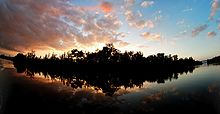- Navigability
-
 Navigation markers, entrance Fremantle harbour and the Swan River, Western Australia
Navigation markers, entrance Fremantle harbour and the Swan River, Western Australia
A body of water, such as a river, canal or lake, is navigable if it is deep, wide and slow enough for a vessel to pass. Preferably there are few obstructions such as rocks or trees to avoid. Bridges must have sufficient clearance. High water speed may make a channel unnavigable. Waters may be unnavigable because of ice, particularly in winter. Navigability depends on context: A small river may be navigable by smaller craft, such as a motor boat or a kayak, but unnavigable by a cruise ship. Shallow rivers may be made navigable by the installation of locks that increase and regulate water depth, or by dredging.
Contents
Inland water transport systems
Inland Water Transport (IWT) Systems have been used for centuries in countries including India, China, Egypt, the Netherlands, the United States, Germany, China, and Bangladesh. In the Netherlands, IWT handles 46% of the nation's inland freight; 32% in Bangladesh, 14% in the United States, and 9% in China.
In the United States
What constitutes 'navigable' waters can not be separated from the context in which the question is asked. Numerous federal, and some states, define navigability for various purposes from admiralty jurisdiction to pollution control,and from property boundaries to the licencing of dams. The numerous definitions and jurisdictional statutes have created an array of case law specific to which context the question of navigability arises. Some of the most commonly discussed definitions are listed here.
Navigable waters of the United States, as defined in 33 CFR 329, are those waters that are subject to the ebb and flow of the tide and/or are presently used, or have been used in the past, or may be susceptible for use to transport interstate or foreign commerce while the waterway is in its ordinary condition. Section 10 of the Rivers and Harbors Act of 1899 (33 U.S.C. 403), approved 3 March 1899, prohibits the unauthorized obstruction of a navigable water of the U.S. This statute also requires a permit from the U.S. Army Corps of Engineers for any construction in or over any navigable water, or the excavation or discharge of material into such water, or the accomplishment of any other work affecting the course, location, condition, or capacity of such waters.
Also, the Clean Water Act use the terms "traditional navigable waters," and "waters of the United States" to define Federal agency jurisdiction under the Clean Water Act. Here, "Waters of the United States" include not only navigable waters, but also waters with "a significant nexus to navigable waters"; both are covered under the Clean Water Act. The terms "navigable" and "significant nexus" are still open to judicial interpretation as indicated in two U.S. Supreme Court decisions: "Carabell v. United States" and "Rapanos v. United States"[1].
Examples
Inland water transport system in India
Main article: Inland Waterways Authority of IndiaIn India there are currently three National Waterways totaling a distance of 2921 km. They are:
- Haldia Allahabad stretch of the Ganges Bhagirathi Hooghly river system (1620 km) in October 1986 as National Waterway 1
- Saidiya Dhubri stretch of the Brahmaputra river system (891 km) in September, 1988 as National Waterway 2
- Kollam-Kottapuram (in Kerala) stretch of West Coast Canal (410 km) along with Champakara canal and Udyogmandal canal in February, 1993 as National Waterway 3
It is estimated that the total navigable length of inland waterways is 14500 km. A total of 16 million tonnes of freight is moved by this mode of transport.
Advantages of inland water transport systems
Waterways provide enormous advantages as a mode of transport compared to land and air modes of transports.
- Cheaper capital cost - Nature has already done the initial engineering work for the transportation infrastructure. Thanks to this gift of nature, the cost of developing an inland waterway is 5-10% of the cost developing an equivalent railway or a four-lane expressway., January 2010
- Cheaper maintenance cost - The maintenance cost of an inland waterway is only 20% of the maintenance cost of an equivalent roadway., January 2010
- Greater fuel efficiency (low cost of transportation) - It is estimated that 1 liter of fuel can move 105 ton-km by inland water transport. Whereas the same amount of fuel can move only 85 ton-km by rail and 24 ton-km by road. By air, it is even less.
- Easy integration with sea transport - Inland water transport can easily integrated with sea transport and hence it reduces the extra cost required for land-sea or air-sea transport interface infrastructure development. It also reduces the time taken to transfer the goods to and from sea transport vessels.
Disadvantages of inland water transport systems
- Low availability of inland waterways - As mentioned above, there are numerous criteria for a water body to be navigable. Out of the total inland water body available in the world, only a very low percentage of it is potentially navigable.
- Low speed - Water transport as a whole is much slower than its road, rail, or air competitors.
See also
- Canal
- Inland Waterways Association, UK
- Inland Waterways Association of Ireland
- Inland waterways of India
- Inland waters of Azerbaijan
- Inland harbor
- Inside Passage
- Inland sea (geology)
- List of canals in France
- Waterway
References
External links
Categories:- Water transport
Wikimedia Foundation. 2010.

